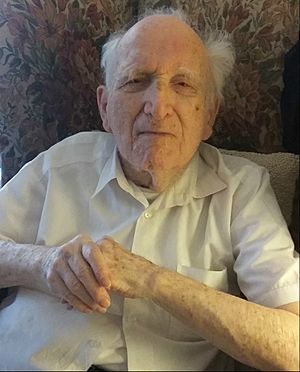Larry Eisenberg facts for kids
Quick facts for kids
Larry Eisenberg
|
|
|---|---|

2016 photo
|
|
| Born | December 21, 1919 New York City, New York, U.S. |
| Died | December 25, 2018 (aged 99) Lincoln, Massachusetts, U.S. |
| Occupation | Short story author and writer of comic verse |
| Genre | Science fiction |
| Notable work | "What Happened to Auguste Clarot?" |
Lawrence Eisenberg (born December 21, 1919 – died December 25, 2018) was an American engineer and a writer. He was known for his science fiction short stories. He also wrote many funny poems called limericks. His most famous story was "What Happened to Auguste Clarot?". It appeared in a well-known book called Dangerous Visions. His stories were published in popular science fiction magazines like The Magazine of Fantasy & Science Fiction.
Larry Eisenberg's Life
Larry Eisenberg was born in New York City in 1919. He grew up in the Bronx during the Great Depression. This was a time when many people faced financial hardship. He went to James Monroe High School. Later, he studied at City College of New York and then at Polytechnic Institute of Brooklyn. There he earned his Ph.D. in Electronics.
During World War II, Larry served in the Army Air Forces. He worked as a radar operator. In 1950, he married Frances Brenner. She was a political scientist and social worker. They had one daughter and one son. Larry lived in Somerville, Massachusetts when he passed away. He died on December 25, 2018, at the age of 99. His death was caused by complications from acute myeloid leukemia.
For many years, Larry Eisenberg was a biomedical engineer at Rockefeller University. A biomedical engineer uses engineering skills to solve problems in medicine. At the university, he helped lead the Electronics Laboratory. He also taught there until the year 2000. Around 1960, he helped design the first transistorized cardiac pacemaker. This device helps control a person's heartbeat. His pacemaker is now on display at Rockefeller University.
A movie about Larry Eisenberg's life is being made. It is called Meet Larry Eisenberg.
Larry Eisenberg's Writing
Larry Eisenberg published his first short story in 1962. It was called "Dr. Beltzov's Polyunsaturated Kasha Oil Diet". This story appeared in Harper's Magazine. Later that year, his first science fiction story was published. It was named "The Mynah Matter" and appeared in Fantastic Stories of Imagination.
Soon after, Larry's stories were published in many top science fiction magazines. These included The Magazine of Fantasy & Science Fiction and Galaxy Science Fiction. Larry Eisenberg's science fiction stories are often funny. He liked to combine humor with science fiction. He said he enjoyed "wedding humor with science fiction, particularly where some unsavory aspect of our society can be pricked." This means he used humor to point out problems in society.
Many of Larry's stories feature a character named Professor Emmet Duckworth. Professor Duckworth is a research scientist. He won the Nobel Prize twice. The Nobel Prize is a very important award given for great achievements. Duckworth's "bright ideas seem great at first but always end in disaster." Some of these stories were put together in a book. It was called The Best Laid Schemes and was published in 1971.
Larry Eisenberg is most famous for his short story "What Happened to Auguste Clarot?". This story was published in a collection of stories called an anthology. The anthology was Dangerous Visions, edited by Harlan Ellison. His stories also appeared in other anthologies. These included Great Science Fiction of the 20th Century.
Larry also published two books of limericks in 1965. A limerick is a short, funny poem. He gained many fans for the limericks he posted online. He would put them in the comments section of articles in The New York Times. Some people even called him the "closest thing this paper has to a poet in residence."

